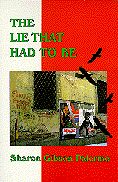


|
The Lie That Had to Be.
Sharon Gibson Palermo. Subject Headings:
Grades 8 - 10 / Ages 13 - 15. *** /4
|

excerpt:
At school they showed a film about the war. Row after row, the children craned their necks, eyes glued ahead. The big square screen loomed above them. Music cheered. The announcer's voice filled the room. "Valiantly our boys will meet the enemy. We are ready for Hitler's army!" In black and white, parades of German soldiers thrust stiff legs forward - tin men come alive. "We must stop the march of evil forces," boomed the voice. "We must pray for our brave boys who have gone to fight. We must break the armies who would control the world."Outside there was bragging about older brothers who'd joined up. Julie was the worst, sticking her nose in the air. "My brother, Tom, was one of the first ones. We're so proud of him. Daddy says there isn't a better thing a boy could do."
Giorgio spoke up with vehemence. "Does your brother know what they've done to my father, and Rennie's? They hate Hitler, too, but now my father can't work in the mine. And Rennie's got arrested! Just because they're Italian! They do the same good work that everyone else does. My father says he'd be ashamed to be a Canadian soldier because of what they've done to us!"
Julie's eyes flamed with passion. "My brother's good! He would never hurt good people!" Rennie could almost feel Papa's protective arms around her, but Julie's eyes were powerful. Rennie kept her voice low. "What did my father ever do bad?"
 This novel, by Sharon Gibson Palermo, gives anything but a black-and-white picture of the impact of the Second World War on the community of Whitney Pier, Nova Scotia.
This novel, by Sharon Gibson Palermo, gives anything but a black-and-white picture of the impact of the Second World War on the community of Whitney Pier, Nova Scotia.
For Rennie Trani, a ten-year-old girl whose Italian-born father is interned, it is difficult to distinguish friend from foe. The man who arrested her father is sympathetic to her and the Italian community. Yet her best friend, Julie, and her family now perceive Rennie's family to be the enemy.
The story centres around the insurmountable differences the situation creates for Julie and Rennie. Julie's family's hostility towards the Italian family is rooted in fear for the son Tom's life as he fights in the war. Julie, in particular, is fearful because she has lost Tom's ID bracelet which she feels would allow her to protect him in some way. Rennie has the bracelet but because of Julie's harsh words and cruel treatment, she chooses to hide it rather than return it to her. By the time Rennie does return the bracelet, Julie cannot forgive her, although Rennie leaves the door open for their friendship in the future.
Rennie must not only deal with Julie but the larger community in general. To make her father, a baker, proud, she makes bread sticks to sell. While many of the neighbours are willing to buy them, the hostility of certain townspeople causes her mother to forbid Rennie's sales. At the end of the novel, Rennie's father returns to his family, one of the fortunate Italian detainees whose internment lasted only a few months. As Palermo points out in her epilogue, many were detained for two years and more and returned to find that their businesses were lost and their families bereft.
The best quality of this historical novel is that, while informing young readers about the internment of Italo-Canadian citizens during World War II, it engages them in a moving story about growing through adversity. In a brief prologue and epilogue, Palermo sets her novel in its historical context, revealing that approximately seven hundred Italians were interned during the Second World War. She also gives references for readers to pursue. Fortunately, the historical detail never overshadows the human factor.
My only quibble is with the novel's ambiguous title. Presumably the lie in question is Rennie's hiding of Julie's bracelet. The lie may be necessary to the plot but the whole point of representing any moral dilemma is to show that we make a choice between the truth and a lie. Despite this one flaw, I found the novel itself very moving.
Recommended.
Kathleen Kellett-Betsos is assistant professor in the Department of French at Ryerson Polytechnic University in Toronto.

To comment on this title or this review, send mail to cm@umanitoba.ca.
Copyright © 1997 the Manitoba Library Association. Reproduction for personal use is permitted only if this copyright notice is maintained. Any other reproduction is prohibited without permission.
Published by
The Manitoba Library Association
ISSN 1201-9364
AUTHORS |
TITLES |
MEDIA REVIEWS |
BOOKSHELF
BACK ISSUES |
SEARCH |
HOME